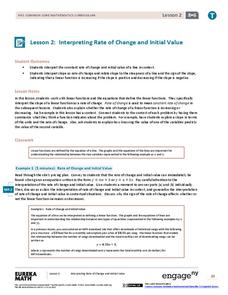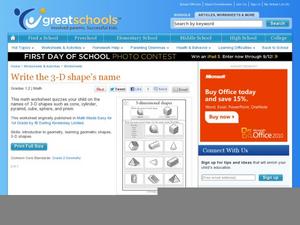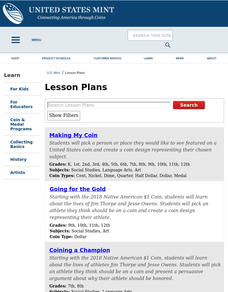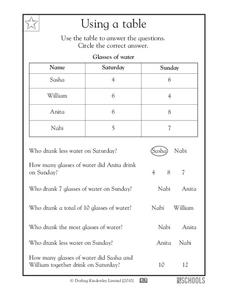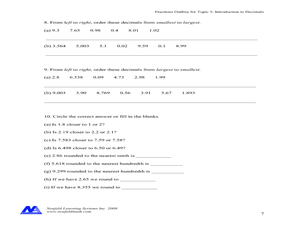EngageNY
Construct an Equilateral Triangle (part 2)
Triangles, triangles, and more triangles! In this second installment of a 36-part series, your young mathematicians explore two increasingly challenging constructions, requiring them to develop a way to construct three triangles that...
Noyce Foundation
Part and Whole
Now you'll never have trouble cutting a cake evenly again. Here is a set of five problems all about partitioning shapes into a given number of pieces and identifying the fractional amount of each piece. As learners progress through the...
Curated OER
Using Graphs
Print and use this useful unit on basic algebraic functions, domain, range, and graphing. Tasks include, illustrating simple functions with a graph, and identifying the domain and range of the function. This twelve-page packet contains...
EngageNY
Interpreting Rate of Change and Initial Value
Building on knowledge from the previous lesson, the second lesson in this unit teaches scholars to identify and interpret rate of change and initial value of a linear function in context. They investigate how slope expresses the...
EngageNY
Tax, Commissions, Fees, and Other Real-World Percent Problems
Pupils work several real-world problems that use percents in the 11th portion of a 20-part series. The problems contain percents involved with taxes, commissions, discounts, tips, fees, and interest. Scholars use the equations formed for...
EngageNY
Solving Area Problems Using Scale Drawings
Calculate the areas of scale drawings until a more efficient method emerges. Pupils find the relationship between the scale factor of a scale drawing and the scale of the areas. They determine the scale of the areas is the square of the...
Curated OER
Write the 3D Shape's Name
Can your first graders identify a cone? What about a cube? Or a prism? Help them find the differences between these shapes with this worksheet, which provides a word bank for three-dimensional shapes. For extra practice, bring in...
EngageNY
Independent Reading: Building The Power of Stamina
The Incredible Book-Eating Boy is read aloud to young readers, and the story is discussed. Then, the lesson goes into how to build up one's reading stamina. The class brainstorms ways that they can build up their stamina such as: staying...
CCSS Math Activities
Smarter Balanced Sample Items: High School Math – Target A
Don't get irrational about rational exponents. A PowerPoint presentation highlights the sample high school questions from the Smarter Balanced Assessment Consortium (SBAC) Claim 1 Target A item specifications. As one part of a larger...
Curated OER
Charting History With Pennies
Young scholars collect pennies and sort them in ascending order of dates. For the year on each penny, students research key events in history and pick a single event, explaining its historical significance. Then young scholars use these...
DK Publishing
Who's First?
Put ribbons, rabbits, and shapes in order with a number sequence activity. Three different activities reinforce counting and number sequence, as kindergartners color particular items and identify the first, second, and third in various...
Curated OER
Using a Table
Tables are no help if your scholars can't read them; provide some excellent beginner-practice using this table example and accompanying comprehension questions. Learners examine the data first, which charts the number of glasses of water...
Curated OER
Similar Shapes
In geometry, similar and congruent shapes are often confused. Shapes that are similar are the same shape, but a different size. This activity gives young learners some practice in identifying similar shapes. There are five polygons...
Curated OER
Two-Digit Quotients
In this mathematics worksheet, 6th graders find the quotient for each problem. They estimate first and identifying which number they will use. Then, students divide the problem and multiply to check.
Curated OER
Practice With Patterns
For this pattern worksheet, students explore sequence of numbers. They identify the next number in a sequence. This one-page worksheet contains 30 problems. Students may check their answers online.
Curated OER
Graphing Polynomials
Students graph polynomial equations using different methods. For this algebra lesson, students identify the different ways the x and y values relate in a graph. They solve for x by finding the zero's of the polynomials.
Curated OER
Whole Numbers
A game is a great way to learn. Study what makes an integers, their traits, and characteristics. This instructional activity includes 3 separate activities intended to promote an understanding of integers, whole numbers, and opposites....
Wild BC
The Greenhouse Effect: The Role of CO2
Though this is meant to be second in a two-part activity, the two are not dependent on each other. Pupils play the roles of visible light rays, light or dark surfaces, and carbon dioxide molecules. They interact and react according to...
Curated OER
Introduction to Decimals
Young math whizzes complete the online instruction, then solve 20 problems about identifying decimals, comparing decimals and fractions and ordering decimals.
Curated OER
More, Less or Equal
In this math worksheet, students compare sets and determine how they compare. Students count the size of small sets using the numbers 0 to 20 and identify if the sets are equal in size, larger or smaller.
Curated OER
Independent Practice 1: Box and Whisker Plot
In this box and whisker plot worksheet, students create a box and whisker plot from a given set of data. They identify the lower quartile, upper quartile, the mean, and outliers. This one-page worksheet contains 20 sets of numbers from...
Curated OER
Z-Scores related to Psychology
In this z-score worksheet, students identify the z-scores and percentiles corresponding to thirteen values. Students are also asked to find two probabilities. Worked solutions are provided after each question.
Curated OER
Kinetics Practice 2-Key
In this kinetics worksheet, students solve seven problems related to chemical reactions and their rates. Students identify rate laws for mechanisms, they draw reaction diagrams, and they determine rate constants.
Curated OER
Comparing Numbers
In this comparing activity, students compare decimals and percents. They identify the largest and smallest number in a dequence. This one-page activity contains 10 multiple-choice problems. Answers are provided.





